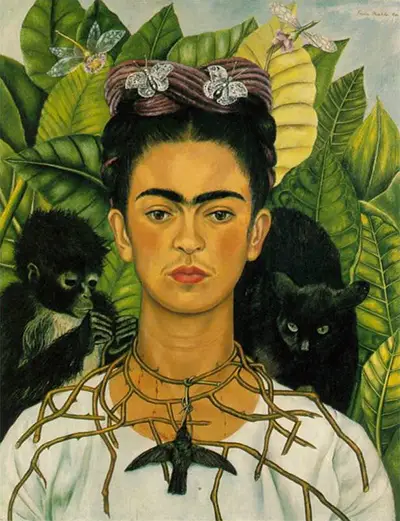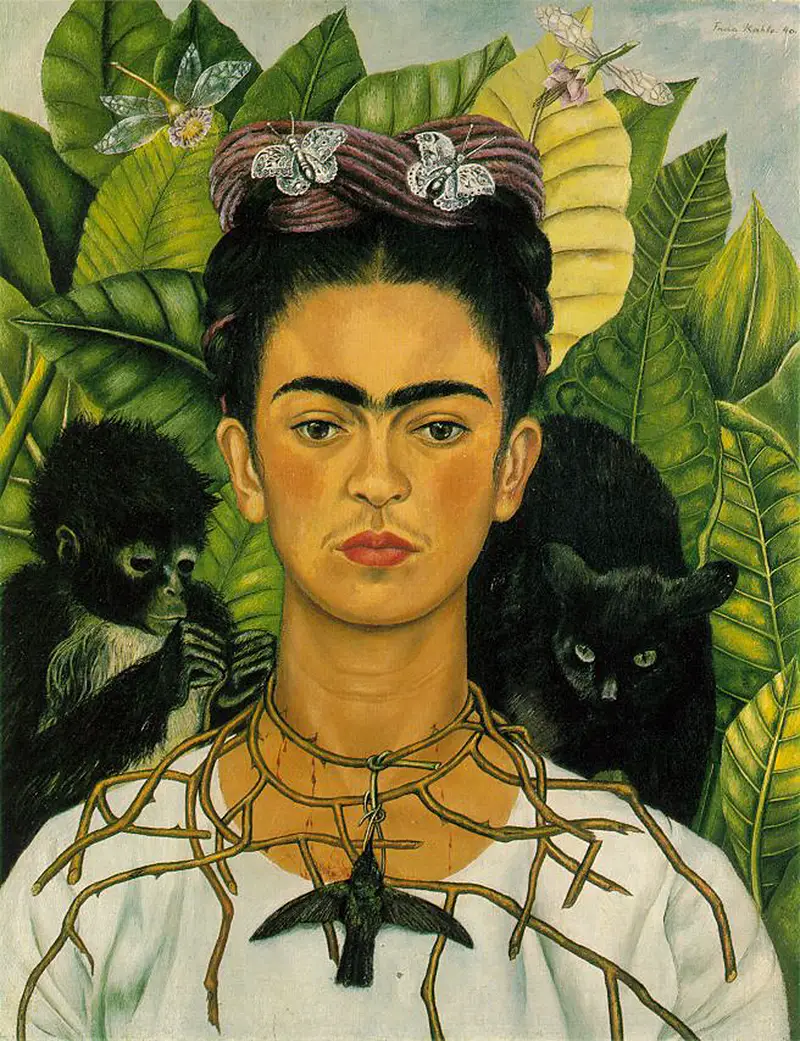Ironically, she remarried Rivera later that year and Muray purchased the painting to assist Kahlo's financial situation. Kahlo painted fifty-five self portraits and though many saw her as a surrealist, Kahlo commented that she painted "reality" and the subject she knew best - herself. Painting was also a coping mechanism during difficult times and in this fascinating portrait she portrays her feelings using both Christian and Aztec symbology. The painting is beautifully balanced, Kahlo's face is the focal point of the image. Though her eyes do not directly engage with the viewer, they are slightly downcast and appear sad, forcing the viewer to consider her private thoughts and feelings.
On her right shoulder sits a unlucky black cat, on her left shoulder is a monkey, possibly one of her pets, a gift from Rivera. The monkey, often a symbol of the devil, tugs at the thorn necklace around her neck, drawing blood. The thorn necklace reflects the pain and suffering she feels and its use in this image has been compared to the crown of thorns worn by Christ. Kahlo is presenting herself as a martyr, someone who takes on extreme pain and suffering for the benefit of us all, just as Christ is believed to have done. Many elements of this composition have provided a sense of self-idolisation that has been also identified in some of her other self-portraits.
Butterflies appear in her hair as symbols of resurrection too. The addition of the lifeless hummingbird dangling from her neck is of interest, as hummingbirds are often used to symbolize the Aztec god of War known as "Huitzilopochtli". Other historians have claimed that the creatures surrounding Kahlo are a further connection to her Christian martyrdom, drawing on other themes from the Bible. A bird hangs from her necklace, with an appearance which matches directly with the artist's famous style of eye brow - surely not a coincidence that the two are so similar? The bird's pose could also be a symbol of Christ's Crucifixion, in the same way that others would wear crosses around their neck.
Whilst the shape of the hummingbird mirrors the monobrow which Kahlo appears to have emphasized, there is also the semblance of a moustache above her mouth. This was probably a deliberate feminist statement. The background of the picture is filled with Mexican flora and fauna and provides a contrast with the more open, blank foreground. The original painting is now housed at the Harry Ransom Center, University of Texas, Austin. It is an extremely popular and important piece which has been lent to many other museums under strict criteria. When it travels, the painting has its own seat and personal courier. Kahlo's Self Portrait with Thorn Necklace and Hummingbird is a wonderful image of a talented painter and her innermost thoughts.
Frida Kahlo placed a great importance on animals in her life. You will find her deer appearing in Wounded Deer, as a Surrealist self portrait. She treated a number of her pets as surrogate children and this love was underlined by their featuring in several of her paintings. Perhaps their innocence appealed to her, and she may have felt that these were the only creatures that she felt able to truly trust after so many knocks in her life - both physical and mental. These wounds are also captured in The Broken Column, where she reflects on her inner and external turmoil.In truth, these very same would are touches on again and again, through a number of different self portraits right across her lifetime ouevre.


